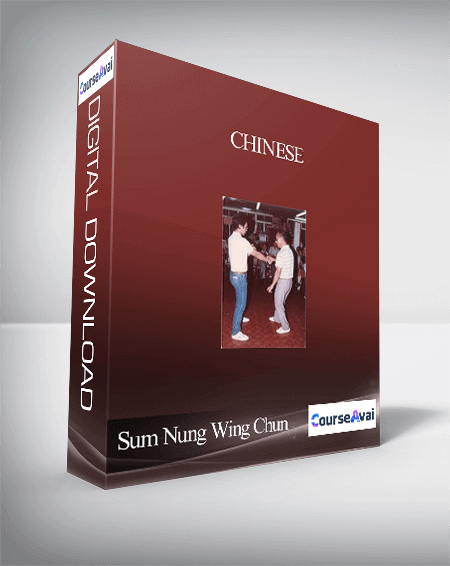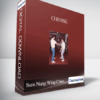$29.00 Original price was: $29.00.$28.00Current price is: $28.00.
Wing Chun is not a technical style. It is a conceptual system. More than a set combinations of pre-conceived movements, it is an ingenious index and guide to the core principles of Southern Chinese martial arts.
 Purchase this course you will earn 28 Points worth of $2.80
Purchase this course you will earn 28 Points worth of $2.80Elevate your skills with the Sum Nung Wing Chun – Chinese course, available for just $29.00 Original price was: $29.00.$28.00Current price is: $28.00. on Utralist.com! Browse our curated selection of over 60,000 downloadable digital courses across diverse Personal Development. Benefit from expert-led, self-paced instruction and save over 80%. Start learning smarter today!
Wing Chun is not a technical style. It is a conceptual system. More than a set combinations of pre-conceived movements, it is an ingenious index and guide to the core principles of Southern Chinese martial arts.
Purchase Sum Nung Wing Chun – Chinese courses at here with PRICE $29 $28
DOWNLOAD INSTANTLY
PLEASE CHECK ALL CONTENTS OF THE COURSE BELOW!
 Sum Nung Wing Chun – Chinese
Sum Nung Wing Chun – Chinese
Sum Nung Wing Chun – Chinese
Wing Chun is not a technical style. It is a conceptual system. More than a set combinations of pre-conceived movements, it is an ingenious index and guide to the core principles of Southern Chinese martial arts. Thus, in the Wing Chun system of Yuen Kay San as taught by grandmaster Sum Nung, it is the yiu dim (yao dian, important pointers) that are vital, since from them come the many individual applications and implications.
There are many important concepts in Wing Chun such as “simultaneous defence and counter offense”, “techniques come from the heart”, “sticking hands is like asking the way” and one of the most important, the “centre line”.
Centreline Concept
The Meridian Line, sometimes referred to as the central line, sagittal place, etc. is behind many of the major concepts of Wing Chun. Like most Chinese concepts, it can be viewed in several different ways. It :
- defines the line that vertically bisects the practitioner’s body from the crown-point all the way down to the central point between the feet
- indicates the same line through an opponent’s body
- encompasses the most direct root between the practitioner’s center and that of the opponent
Wing Chun seeks advantage by aligning its structure and weapons on the central meridian, striking the opponent’s center of balance and maintaining dominance of the line between the two throughout combat.
|
In addition to the general principles, Yuen Kay San left behind several formal written sets in poetic form, including the sup yee faat (shi er fa, twelve methods). It is a group of keywords organized by Yuen Kay Shan and Sum Num to express their core concepts. Practitioners of the Yuen Kay San / Sum Nung Wing Chun lineage apply these methods together with their techniques during applications. The twelve methods provide a gateway to deeper understanding of the style. Anyone who fights purely with techniques without these methods will not possibly be able to execute them to the fullest potential.
|
Although each of the twelve methods can be interpreted and applied in different ways, basic explanations can help give insight into their potential.
- Darp (搭) means ‘to bridge the opponent’s arm’
- Jeet (截) means ‘to intercept’
- Chum (沉) means ‘to sink’
- Biu (标) means ‘to thrust or charge forward’
- Chi (黐) means ‘to stick and follow’
- Mo (摩) means ‘to feel or slide along the skin with mild pressure’
- Tong (熨) means ‘to apply stronger pressure on opponent’s arm to hold, seal or trap’
- Dong (荡) means ‘to swing or change direction’
- Tun (吞) means ‘to pull in, draw in or guide in’
- Chit (切) means ‘to cut off opponent’s incoming offensive route’
- Tao (偷) means ‘to steal or create a false strike into opponent’s ‘
- Lao (漏) means ‘to run hands, sneak and slide into opponent’s loop holes usually after stealing’
Bridging is to make contact with the arms. Intercepting involves stopping the opponent’s strike on his way in before it gets too close. Sinking deals with the destruction of the opponent’s structure. Darting advocates the relaxed and accurate thrusting of power. Sticking relies on contact to gather information. Feeling uses contact to maintain positioning during the dynamics of combat. Pressing applies power like an iron on clothing. Swinging turns the reactions of opponents against them. Swallowing accepts an opponent’s power instead of resisting it. Slicing carves into an opponent to disrupt their center of gravity. Stealing fills the empty holes in an opponent’s defense. Leaking runs through an opponent’s actions.
Tactical advice is passed down in the system through sets of four character rhyming couplets such as the yiu ku (yao jue, important rhymed formulae) and the similar faat mun (fa men, methodologies).
These formulae impart advice including; as force comes, it should be received and kept. It is never resisted or knocked away but accepted and adhered to. As force goes, it is accompanied, escorted back, and added to. When a loss of contact occurs, or the body is crossed, a practitioner is advised to charge straight down the central meridian.
Wing Chun kuen does not prepare or plan out ahead of time and stubbornly enact these plans regardless of circumstance. It attacks according to current conditions and is alive and ever changing. Every offense is a defense and each defense is an offense. When changes are done skillfully, a practitioner can achieve twice the results with only half the effort.
Wing Chun kuen boxers must learn to apply their power in the most advantageous way, moving with the wind rather than against it. Its power is soft, calm, and quiet. Practitioners must therefore have faith in themselves to use it. Soft is employed to overcome hard, but both hard and soft are combined in use. Enemies are fought fiercely and attacks may be initiated in order to gain control. Once an initial attack is made, it is followed in succession until the target is no more.
Sets of five character rhyming couplets pass along training principles in the Yuen Kay San system. They include the yiu jee (yao zhi, important ideas) and the ching yan (qian yin, introductions). These sets relate to working hard, being healthy, studying, being nimble, using the eyes, and being first.
Some of the training principles include that strength must be exacting in position, never overextended. It is aware, follows, and changes with feeling. During training, the eyes should be angry and look straight forward. Changes should be explored through sticking with a partner. A teacher must correct these practices. When there is no teacher and no partner, a mirror and dummy should be used to aid in this pursuit and one must imagine an enemy is present.
In addition, practitioners are advised to follow the methods of the ancestors, but to remember to change according to conditions. Lastly, it is said that if one works hard and trains, one is unlikely to meet with failure.
Purchase Sum Nung Wing Chun – Chinese courses at here with PRICE $29 $28
Cultivate continuous growth with the Sum Nung Wing Chun – Chinese course at Utralist.com! Unlock lifetime access to premium digital content, meticulously designed for both career advancement and personal enrichment.
- Lifetime Access: Enjoy limitless access to your purchased courses.
- Exceptional Value: Benefit from savings up to 80% on high-quality courses.
- Secure Transactions: Your payments are always safe and protected.
- Practical Application: Gain real-world skills applicable to your goals.
- Instant Accessibility: Begin your learning journey immediately after buying.
- Device Compatible: Access your courses seamlessly on any device.
Transform your potential with Utralist.com!
Related products
Health and Medical
= 21 Points
Personal Development
Watch What You’re Saying! How to Powerfully Understand Non-verbal Communication – Dot Bekker
= 29 Points
Personal Development
= 47 Points
Personal Development
= 25 Points
Personal Development
= 35 Points
Personal Development
= 45 Points
Health and Medical
= 28 Points
Personal Development
= 43 Points




 Sum Nung Wing Chun – Chinese
Sum Nung Wing Chun – Chinese







